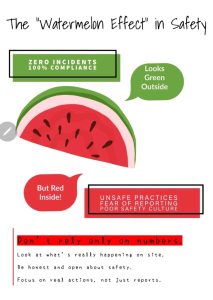The “watermelon effect” in safety refers to a scenario where safety performance appears excellent on the surface, often represented by green indicators such as zero incidents or full compliance. However, beneath this outward appearance lie serious underlying issues — the “red” interior, such as unsafe behaviours, unreported incidents, or a poor safety culture. It’s a misleading picture where everything looks good externally, but hidden risks and problems persist internally.
Green on the Outside
What leaders see are:
- Zero reported incidents: No injuries or accidents logged.
- 100% compliance: Checklists are always complete, and paperwork is in order.
- Training records up to date: All employees seem/ are trained and competent.
But does this mean the site is truly safe?
Not always.!!!
Red on the Inside
What’s really happening:
- Unsafe behaviours continue: Workers may cut corners to meet deadlines.
- Fear of reporting: Employees hesitate to report near misses or hazards out of fear of being blamed or punished
- Tick-box culture: Safety checklists are completed mechanically, without genuine inspection or concern.
- Poor engagement: Frontline workers feel disconnected and unheard by management.

Why Does This Happen?
- Over-focus on metrics: Companies sometimes prioritize looking good in reports over solving real issues on the ground.
- Fear-driven silence: Workers fear being blamed, punished, or seen as troublemakers if they always report safety concerns.
- Checklist mentality: Completing forms becomes more important than meaningful safety actions because organizations want to look good on paper.
- Pressure to perform: Managers may feel compelled to present perfect numbers to senior leadership, that everything is good.
- Lack of trust and communication: When ground-level feedback is ignored, problems go unaddressed.
The Hidden Risk
We think everything is fine, but serious risks may still exist. This false sense of safety can lead to major incidents that “no one saw coming.”
The Real Solution
- Promote open reporting: Create an environment where workers feel safe to report hazards and near misses without fear.
- Focus on real behaviour, not just numbers: Prioritize actions that improve safety culture, not just what looks good in a report.
- Listen to your people: Engage with workers on a regular basis. Ask for their insights — and act on them.
- Lead by example: Supervisors and managers should model honest, safety-first behaviour.
- Reward honesty, not perfection: Celebrate learning from mistakes and continuous improvement, not just “no incidents.”
True safety isn’t about perfect numbers. It’s about creating a culture where people feel confident to speak up, and where real actions are taken to keep everyone safe every day.



